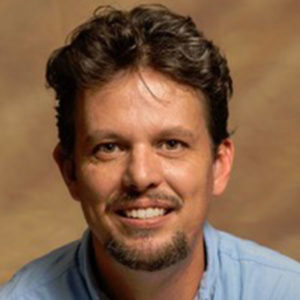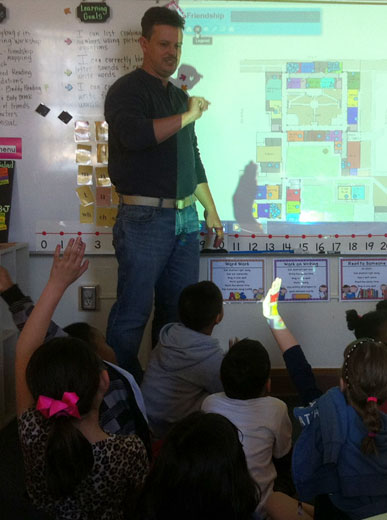Outdoor Learning and GIS Day Activities with K-5th Grade in Arizona
 GeoMentor Volunteer: Chuck Powell
GeoMentor Volunteer: Chuck Powell
Location: Tucson, Arizona
Grade level of participating students: K – 5th
Activity Theme/Focus:
- K/1: Maps and Spatial Vocabulary
- 2/3: Maps and Data Collection
- 4/5: Mapping and Scale, Data Collection, and Analysis
- Teachers: Professional development workshop on ArcGIS Online and hands-on training using Survey 123 and Collector.
Number of Participants: We are trying to reach all 420 students in 16 classes. I have worked with 13 of the 16 classes so far.
How did you connect with your collaborator? I was walking in my child’s school and they had a huge map of the playground and the equipment usage in the hallway. I realized the kids and teachers were using GIS and maybe I could help. I walked into the classroom, introduced myself to the teacher, and asked if I could help in any way. Volunteering at the school is usually my best day of the week.
This is the mission statement for my child’s school: “A school where students learn to ask big questions and engage in authentic, real world learning to become change makers, creators of new knowledge and stewards of the earth.” Perfect for GIS.
Describe your collaboration process: We initially met and introduced the Outdoor Learning Teacher to GIS. We discussed how her projects directly connected to GIS and how we could extend student learning by including GIS in various ways. I showed her examples of story maps and building maps. She then set up time for us to work with the students, but she wasn’t initially directly involved in the GIS teaching. It took her a year to get comfortable with integrating GIS into the classes; but once we participated in weekly meetings to discuss student projects, she really got engaged. After attending the ESRI education conference, she was fully onboard to expand student exposure to GIS. We meet weekly to either work on activities or have tutorials using Survey123, Collector, or other apps.
This year, I am at the school every Wednesday morning from 8-12. I meet with the Outdoor Learning Teacher for about 20 or 30 minutes before the first class comes. We also communicate by email in advance of the classes. These efforts are more of a brainstorming activity for us than planning. Since the school’s approach is project based learning, we look at what the students are working on and devise plans and activities based on their projects directly.
- What is the project?
- What data needs to be collected?
- Is there a spatial need for the project?
- Is there technology we can use to facilitate data collection?
After that is done we come up with a plan for lectures, classroom/outdoor activities, and workshops for teachers.
 Describe your tasks/involvement: We have held GIS Day at the school for the past 3 years. Last year, two other GeoMentors participated in GIS Day as well. Every grade level (K-5) has been introduced to ArcGIS Online and a GIS activity in some form or fashion. This year we were invited to Pima County GIS Fair to host a booth where the students demonstrated some of the GIS activities they completed over the past two years. They showed how they used ESRI Collector to collect data and pictures around the school using offline tablets. They also demonstrated the use of ArcGIS online to create web maps and apps. Their examples included a tour of the school gardens with various outdoor features and the milkweed garden where they are studying Monarch butterflies.
Describe your tasks/involvement: We have held GIS Day at the school for the past 3 years. Last year, two other GeoMentors participated in GIS Day as well. Every grade level (K-5) has been introduced to ArcGIS Online and a GIS activity in some form or fashion. This year we were invited to Pima County GIS Fair to host a booth where the students demonstrated some of the GIS activities they completed over the past two years. They showed how they used ESRI Collector to collect data and pictures around the school using offline tablets. They also demonstrated the use of ArcGIS online to create web maps and apps. Their examples included a tour of the school gardens with various outdoor features and the milkweed garden where they are studying Monarch butterflies.
For the remainder of this year, we will be concentrating on data collection and presentation of the data. We have four long-term projects planned for the students:
- Use Story Map and App Studio to create a spatial tour of the school for prospective parents and students to use.
- Use Collector and ArcGIS Online to create a map and database of the school’s Gardens:
- Milkweed Garden: Monarch butterfly observations
- Community Garden: Crops and student activities within the garden
- Classroom Gardens
- Use ArcGIS Online App Builder to create an app for the school’s Environmental Learning Laboratory (BELL-3 acre outdoor education classroom on the campus).
- Work with the Hiking Club (4th and 5th graders) on impacts to Saguaro National Park, both inside and outside the boundaries.
What did you gain from the experience? What do you think the participants gained? I believe I am a better consultant after working with kids. I’ve been forced to use a totally different vocabulary with a different audience. I’ve also learned new GIS programs such as ArcGIS Online, Collector, and Survey 123 for the school; now my company uses these tools every day as well. Without working with the school, the learning curve would have been much steeper. Working as a GeoMentor has been an amazing experience. The kids just love using the technology and love solving problems. It’s the same reason I love GIS.
My educator collaborator and students gained invaluable experience with GIS, technology, data analysis, and problem solving. GIS allowed all involved to take their learning from basic projects to expand to sharing with the world. Students recognized learning connections to what they are studying now to what they can do for a career. The teacher found it incredibly valuable to show student learning to a larger audience. She also believes that GIS in elementary school is one of the best ways to expect more from students in their work and learning.
Additional comments: My daughter will be starting middle school next year so I would like the GIS exposure/education to continue through to college (this supports a father’s pipe dream where I envision my daughter follows in my footsteps and goes into GIS as a career). In Tucson, we have open enrollment school choice, so setting up a GIS tract is a little difficult but my goal would be GIS K-12. So I am trying to recruit some other GeoMentors to work with the middle school and a high school. I am reaching out to our Magnet Schools (Specialize in STEM, language, Fine Arts, etc.) that Focus in STEM that these students may choose to go after 5th grade.

